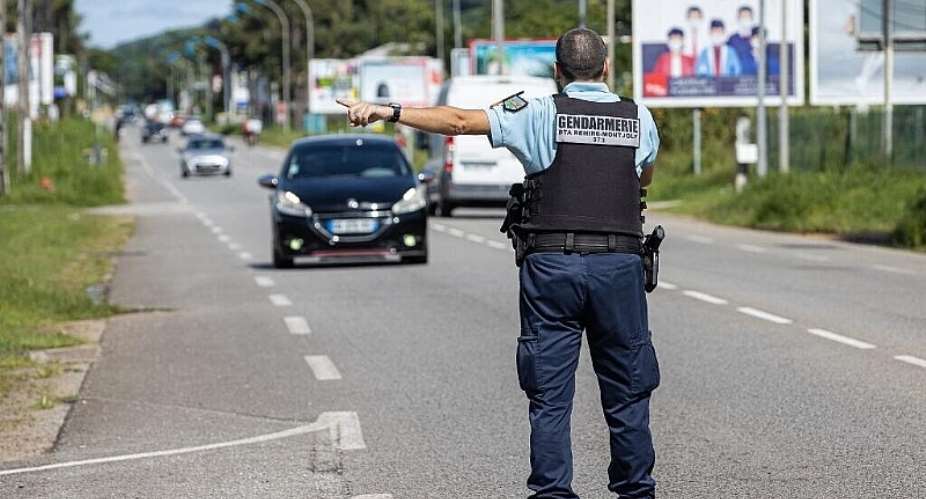The killing of a 17-year-old by French police, who shot the teenager after he failed to comply with a traffic stop, has raised questions over whether a security law permitting police to fire on suspicion of a threat has put the public at risk.
Nahel M. was shot dead by police on Tuesday after committing a French offence known as "refus d'obtemperer" (refusal to obey).
It amounts to failing to comply with an order to stop, issued by a visibly identified member of the police force. The offence is punishable by two years in jail and a €15,000 fine.
Under France's Highway Code, the police can stop any driver and ask to check their documents at any time, regardless of whether an offence has been committed.
Tuesday's lethal shooting was the third of its kind this year. Last year, a record 13 people were killed after not complying with a traffic stop.
According to a tally by Reuters, the majority of victims since 2017 were black or, like Nahel, of Arab origin.
Dangerously broad
There is concern that the number of deadly shootings has increased dramatically since a 2017 law introduced under then president François Hollande, in the wake of the 2015 Paris terror attacks.
Article 435-1 of the home security bill extended the circumstances in which police are allowed to use their firearms.
Police can fire when their life or physical safety, or the life of another individual, is put at risk – or when a place or people under their protection come under attack.
But since 2017 they are also licensed to shoot when they are unable to prevent someone they believe is "likely" to threaten their life or physical safety, or other people's, from fleeing.
Firing is further authorised when police are unable to st op a vehicle whose driver has ignored an order to stop and whose occupants are "likely" to pose a risk to their life or physical safety, or to other people's.
A fifth scenario is when there is "reason to believe" the use of a firearm will prevent murder or attempted murder.
Rights groups say the 2017 law has dangerously broadened the legal framework for when officers can use their firearms.
In an interview on Friday, Henri Leclerc, the honorary president of the French League for Human Rights, said the 2017 law had been "interpreted almost as a licence to kill".
'Citizens' lives at risk'
A study carried out by French researchers found that shootings of motorists by the police had increased five-fold after the law was introduced.
“Based on rigorous statistical analysis of the monthly number of victims of shootings, unfortunately, it is very probable [the law] is the cause of most of the homicides carried out by police officers,” the researchers told French daily Liberation.
They also looked at claims, often voiced by police unions and politicians, that the fatal shootings are the result of an increase in motorists' dangerous behaviour during traffic checks.
Researchers found that while the number of cases of non-compliance had increased by on average 35 percent since 2017, this didn't justify the 350 percent increase in fatal shootings on vehicles for the same period.
“It would seem that the 2017 law has put citizens' lives at greater risk from the police,” they said .
Mathieu Zagrodzki, an associate researcher at the Centre for Sociological Research and Penal Institutions, said that the officer's use of the self-defence clause in the Nahel case was “highly questionable”.
“Police officers were on the side of the car and the vehicle was clearly no t heading in their direction,” Zagrodzki told RFI's sister TV station FRANCE 24.





 S.Africa building collapse kills one, traps dozens: police
S.Africa building collapse kills one, traps dozens: police
 Election 2024: I’m ready to serve Ghana with my heart, energies – Bawumia
Election 2024: I’m ready to serve Ghana with my heart, energies – Bawumia
 We saved Ghana $19million in 2020 elections – EC
We saved Ghana $19million in 2020 elections – EC
 Nobody has ever enticed me with money to rule in his or her favour — Otumfuo
Nobody has ever enticed me with money to rule in his or her favour — Otumfuo
 Limited voter registration: Dumsor will not affect registration, we've rented ge...
Limited voter registration: Dumsor will not affect registration, we've rented ge...
 Back Free SHS policy with legislative instrument to prevent successive govt from...
Back Free SHS policy with legislative instrument to prevent successive govt from...
 Dadieso LPG tanker accident: No live or property lost as speculated, product suc...
Dadieso LPG tanker accident: No live or property lost as speculated, product suc...
 EOCO to return docket on Cecilia Abena Dapaah to OSP over lack of evidence
EOCO to return docket on Cecilia Abena Dapaah to OSP over lack of evidence
 Police, youth clash at Dambai; teenager killed by stray bullet
Police, youth clash at Dambai; teenager killed by stray bullet
 Court convicts student for issuing GHC50,000 dud cheque
Court convicts student for issuing GHC50,000 dud cheque
